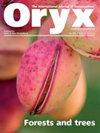狮子的份额:食肉动物的饮食对肯尼亚察沃濒危食草动物的影响
IF 2.1
3区 环境科学与生态学
Q2 BIODIVERSITY CONSERVATION
引用次数: 0
摘要
捕食会对整个生态群落产生连锁调节效应。因此,了解捕食者的饮食可以提供有关其生态和保护以及对猎物种群影响的重要信息。利用 2019-2023 年期间收集的粪便和空中调查得出的猎物丰度估计值,我们描述了肯尼亚察沃地区易受攻击的非洲狮(Panthera leo)种群的猎物消耗和偏好。将生物量模型应用于粪便中的猎物频率发现,85% 的狮子食物由重达 150 千克的大型有蹄类动物组成。在检测到的 16 种猎物中,极度濒危的 Hirola Beatragus hunteri 和濒危的 Grevy's 斑马 Equus grevyi(20 世纪 60 年代作为异地保护计划的一部分引入沙窝的物种)是狮子喜欢的 7 种猎物之一。我们的研究结果可能表明,狮子的捕食对小型喜马拉雅斑马和格雷维斑马种群造成了不成比例的影响。狮子的捕食偏好,再加上可供选择的猎物较多,可能会将小种群的喜乐拉和格列卫斑马困在捕食坑中。我们的研究结果让我们更好地了解了狮子的食性、最佳觅食方式以及捕食者对重要保护景观中受威胁的稀有猎物物种的潜在影响。基于我们的研究结果,我们建议对狮子和其他捕食者在该系统中的捕食生态进行观察研究,以提供关于狮子和斑马在不同年龄和性别下的捕食率的信息,从而进行种群生存能力分析,为沙窝地区这两种濒危珍稀食草动物的管理提供支持。本文章由计算机程序翻译,如有差异,请以英文原文为准。
The lion's share: implications of carnivore diet for threatened herbivores in Tsavo, Kenya
Predation can have cascading, regulatory effects across ecological communities. Knowledge of the diet of predators can therefore provide important information regarding their ecology and conservation, as well as their impacts on prey populations. Using scats collected during 2019–2023 and estimates of prey abundance from aerial surveys, we characterized prey consumption and preferences of the Vulnerable African lion Panthera leo population in Tsavo, Kenya. Biomass models applied to prey frequencies in scats revealed that > 85% of lion diet comprised large ungulates weighing > 150 kg. The Critically Endangered hirola Beatragus hunteri and Endangered Grevy's zebra Equus grevyi (species that were introduced in Tsavo as part of ex situ conservation programmes in the 1960s) were amongst the seven prey species, of 16 detected, that were preferred by lions. Our results potentially indicate a disproportionate impact of lion predation on the small hirola and Grevy's zebra populations. Preferential predation, coupled with high availability of alternative prey, may trap the small populations of hirola and Grevy's zebra within a predator pit. Our findings provide a better understanding of lion diet, optimal foraging and the potential effects predators can have on threatened and rare prey species in an important conservation landscape. Based on our findings, we recommend an observational study of the predation ecology of lions and other predators in this system, to provide information on age- and sex-specific predation rates on hirola and Grevy's zebra for a population viability analysis, to support the management of these two threatened and rare herbivores in Tsavo.
求助全文
通过发布文献求助,成功后即可免费获取论文全文。
去求助
来源期刊

Oryx
环境科学-生态学
CiteScore
5.30
自引率
7.40%
发文量
150
审稿时长
18-36 weeks
期刊介绍:
ORYX—THE INTERNATIONAL JOURNAL OF CONSERVATION, a quarterly journal from Fauna & Flora International, publishes research on biodiversity conservation, conservation policy and sustainable use, and the interactions of these matters with social, economic and political issues. The journal has a particular interest in material with the potential to improve conservation management and practice. Explore the map for details of published articles.
 求助内容:
求助内容: 应助结果提醒方式:
应助结果提醒方式:


